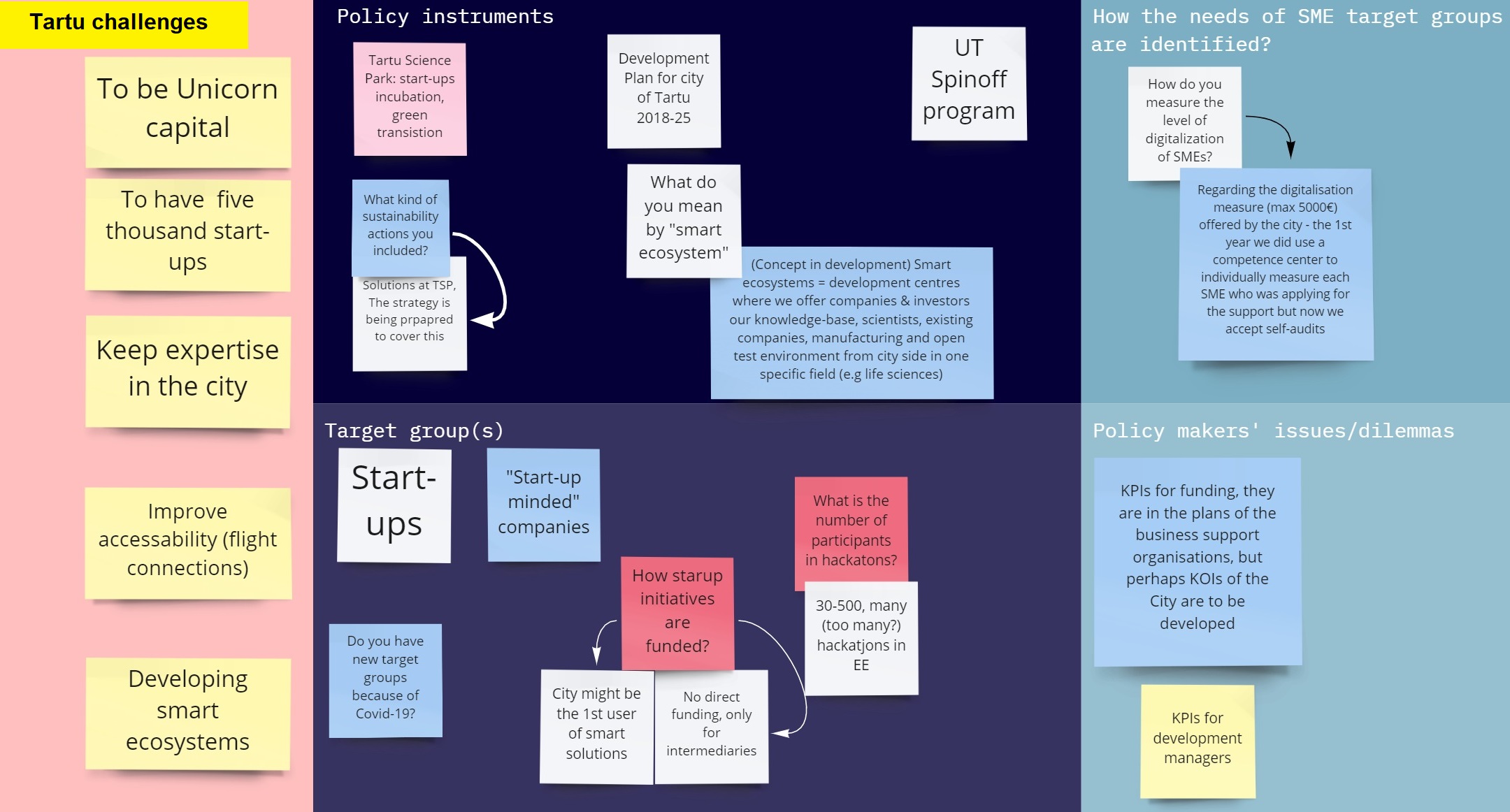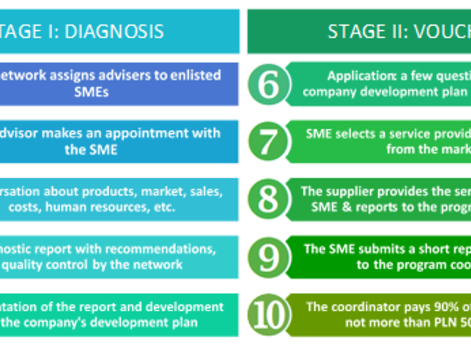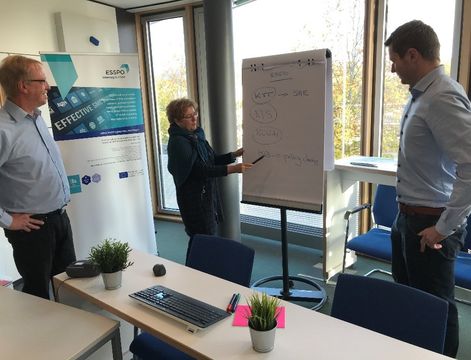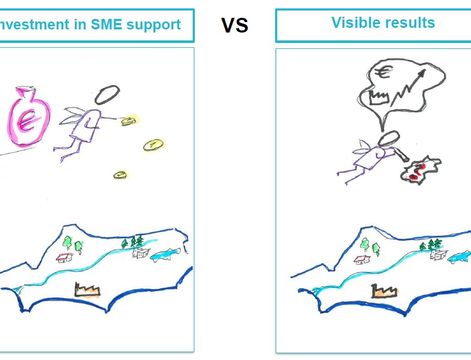
Gabrovo: poistioning SMEs in the new value chains
ESSPO partners review the Gabrovo plan to take-off collaboration structures for SMEs
ESSPO context
So far considerable budgets have been invested across EU for SMEs support measures, however their impact on the economy of EU territories could be improved. Therefore, the aim of ESSPO project is to address the issue of efficiency of SME support policies and develop comprehensive support portfolios designed as policy mixes, which would identify and establish synergies between different services and smartly target relevant segments of SME population.
ESSPO goal
The project takes a long-term approach to contribute to the creation of effective and efficient SME support service portfolios, which are capable to impact the regional economies via increasing SME’s competitiveness, especially focusing on their growth on national and international markets as well as on their improved engagement in innovation processes.
€1,999,669.00
SME competitiveness
ESSPO partners design and deliver mechanisms to improve SME policy instruments in 8 different territories on national, regional, sub-regional and local level.
Tools which are used to implement ESSPO processes involve interregional learning process engaging the stakeholders and project consortium, peer reviews and mapping exercises, finishing with regional action plan of the policy improvement in each territory which is designed in continuous dialogue among partners and relevant stakeholders and accompanied with good practices.
The schemes aim at SME development through incubation and internationalization support services as well as development of new support services by intermediaries. The ambition to improve the conditions for entrepreneurship as well as raise competiveness of SMEs on international markets. These are new schemes, that have not been yet implemented and the detailed mechanisms are to be developed. The assumption is that instead of streamlining the support through intermediaries the demand oriented approach is applied. There is a need to prepare and test the accreditation system for intermediaries who will provide support. Furthermore to make the instrument efficient by targeting support services at specific SME segment groups, manage the suppliers network and monitor the results. At present there are missing experiences on how to select target groups for the support services and how a diagnostic tools for companies needs can be used in the selection criteria of formal structural funds programme. There is little experience in coordination of intermediaries that would help to create synergies of their work and critical mass of support for visible change of the regional companies’ competitiveness. There is a general notion of insufficient quality and scope of the services the intermediaries provide. There is a need to use the scheme to raise the quality and added value of the services.
The first objective is better adapt services offer to SMEs in their structural changes, restructuring actions and anticipation of changes. According to the CIS - 2010 survey, published in 2012, Nord-Pas de Calais firms innovate and invest less. We need to change this situation. The second objective, related to the first, is to improve the effectiveness of our regional ecosystem in order to increase the critical mass, visibility and attractiveness of the areas of specialization retained in our RIS3. Currently our ecosystem is organized to support the development of seven smart specializations : • Railways infrastructures • Design and applications of bio based products • Natural ingredients for health • Organic textiles, polymers and composites • Development and promotion of sustainable aquatic resources • Retail for the future : new forms of exchanges and consumption • Development of components and heavy current electrical chains And finally, we must prepare for the launch of new specializations with the support of an ecosystem adapted to new economic challenges. SMEs companies could also rely on regional strategy to educate and train them in business intelligence (new offer). To meet the challenges described above there is a need for improvement of the policy instrument as the previews approaches need to be adjusted to new situation.
Main aim of this policy is to increase overall entrepreneurial activity and reduce the gap compared with capital, including raising atractiveness of Tartu as both entrepreneurship and living environment within Estonia and internationally. This policy also aims at increased cooperation between academia and industry and development of high value adding products and services.
Policy has defined three strategic goals: Tartu has competitive and sustainable enterprises; Tartu has high-tech economy; Tartu is the best place to start a business and attractive investment environment.
To achieve these goals the policy has described five focused development directions:
1. Development of innovation and growth capacity of entrepreneurship
2. Development of human resource
3. Development of business support system & infrastructure
4. Support for internationalization of entrepreneurship
5. Development of entrepreneurial culture and reputation of entrepreneurship environment
Currently many estonian companies are working as sub-contractors or provide services without ownership of brands or IP or etc. Startup rate in Estonia and also in Tartu has been on positive trend, however they need to be directed toward the ability to provide higher value added products and services to global market in a sustainable manner.
Policy in hand needs to aligned with new national Smart Specialization Strategy and new structural funds programmes to be fully efficient.
The ERDF Operational Programme 2014-2020 of the Basque Country, presents the strategy and thematic objectives of the intervention determined in the Basque Country for the operations financed by the ERDF. The interventions have been organized according to the 11 identified regional needs in order to achieve smart growth. More specifically, need4 (N4) focuses on entrepreneurial support and the creation of new enterprises and N5 enhances the competitiveness of enterprises, especially SMEs. Priority Axis 3 (OT3) targets the improvement of SMEs competitiveness covering N4 and N5. This Axis is focused on boosting entrepreneurship and business creation, enhancing business competitiveness, especially SMEs though financing, promoting growth and internationalization. The objectives of this Axis 3 are: Creation of new enterprises, improving access to financing and advanced services, support to the creation and broadening of advanced capacities for the development of product and services, promote the development and consolidation of SMEs, in particular by improving access to financing, technology and access to advanced support services and promote innovation of SMEs and cooperation for innovation in all fields. These objectives become even more relevant in the current economic crisis that has resulted in a sharp increase of the unemployment rate in the region, and thus, to generate employment is one of the main challenges of the Basque economy for the coming years.
A new demand oriented support system has to be developed to increase the capacity and competitiveness of SMEs trough provision of specific expert services and consultations for project development and implementation in traditional manufacturing sectors, based on the smart specialization of the region. This will improve the implementation process of the Municipal plan of development of Gabrovo municipality 2014-2020, as a local policy instrument and it will support the achievement of Specific goal 1.1. Enhancement of knowledge and provision of information for development of innovations with focus on the priority economic sectors in Gabrovo municipality and Specific goal 3.1 Encouragement of entrepreneurship and stimulation of SMEs in Gabrovo municipality, through application of flexible local incentives and measures within of Strategic goal 1: Stimulation of economic growth and enhancement of competitiveness of local business in Gabrovo municipality. SMEs support system will include services for selected target groups based on assessment of companies’ needs through a diagnostic tool working with selection criteria. The competencies on specific products and technologies of the Technical University of Gabrovo, business NGOs and the local branches of the suppliers’ chains will be used. Enhancement of internationalization through participation in joint projects, innovative pro-EU networks and platforms is also included.
NIF was established in 2003 to implement the objectives of the National Innovation Strategy. It is one of the main national instruments that promotes R&D activities and supports innovative firms with technical feasibility studies and scientific, research and development projects for improving competitiveness and meeting societal challenges. NIF is interlinked with the Structural Funds since 2009 and with the recent OP Competitiveness and Innovations 2014-2020. The Fund is also one of the policy instruments in support of the National Strategy for Smart Specialisation by giving priority and funding projects in prioritised sectors such as ICT and mechatronics, agri-food, transport and logistics, health care, motor vehicles and components, and creative industries.
Due to budget fluctuations NIF has lost position and efficiency as national instrument throughout the years. In the last two years however, there is a raising trend in participation rate and quality of projects submitted by Bulgarian SMEs. In order to respond to the interest and needs of the NIF beneficiaries a monitoring and impact assessment mechanism has to be established for fine-tuning the funding schemes and evaluation criteria of the Fund and to measure its efficiency on the SMEs competitiveness and socio-economic impacts. Since its establishment NIF has never been monitored and there is little experience for such activities by the responsible body.
The main objective of portfolio of measures needed to be improved in Castilla y León is to foster the entrepreneurial spirit in the region as well as SME development through advanced support services and facilities to help companies to growth, collaborate and consolidate as well as gain the international markets. Based on the study of the RIS3, it is necessary to deep in some structural elements which allows to improve the incorporation of the innovation in the companies, and it is necessary to work on the measures of the Operational Programme in issues like to reinforce their competitiveness, to improve their internationalization, foster the creation of new businesses and stimulate business growth from SMEs to mid-cap companies. The improvement will be oriented on the design of policy instrument focused on improving SMEs competitiveness. The new efficient mechanisms are needed to be developed with the aim to target the support services to specific groups of companies with specific needs.
The objective is to intensify the involvement of SMEs in innovation activities, especially in information exchange with regional scientific institutions. Funding is foreseen for “qualified consultancy” for SMEs to motivate them to:
• develop new products or services resp. to improve them
• implement new technologies, Process- or organizational innovations
• cooperate with scientific institutions, preferably regional ones
• join innovation networks
To achieve this, districts in Lower Saxony, namely the departments for business development, can apply for a budget (from ERDF) to hire a consultant, who provides the KTT service to the SMEs on behalf of the district. The SMEs have to be based in Lower Saxony and the project has to be executed in one of the fields of specialization, defined in the RIS3 of Lower Saxony (Mobility => automotive, aviation, shipbuilding, logistics etc., health- and social care, energy, agrofood, digital and creative industries, new materials / industry 4.0, maritime economy => green shipping, offshore etc.).
“Qualified consultancy” (based on de-minimis regulation) may cover consultancy concerning the potential of new technologies, process- or organizational innovations and their implementation. Furthermore it may cover consultancy to develop and implement own product ideas into new products or services.
Consultancy may also include assistance in applications for innovation funding.
First objective is to better adapt services offer to SMEs in their structural changes, restructuring actions and anticipation of changes. If region Centre-Val de Loire is listed among “developed regions” she is still considered as a moderate innovator. We need to change this situation. Second objective, related to the first, is to improve the effectiveness of our regional ecosystem in order to increase the critical mass, visibility and attractiveness of the areas of specialization retained in our RIS3. Currently our ecosystem is organized to support the development of five smart specialization priorities:
• Environmental engineering for High consuming resources activities
• Services and ICT for health and cosmetics
• Systems design for energy storage
• Energy efficiency for building
• ICT and services for heritage tourism
In order to generate socio economic impact through our specialization areas we have to professionalize the member of the regional economic development network, and to design a better offer to SMEs. To meet the challenges described above there is a need for improvement of the policy instrument as the previews approaches need to be adjusted to new situation.
Axis 1 of the ERDF OP addresses both SME competitiveness and the capacities of the region in RDI. It is also closely linked to the S3 objectives (which are also taken into account under ERDF OP’s TO3), and to the Regional Economic Development Strategy for innovation & internationalization (SRDEII).

ESSPO partners review the Gabrovo plan to take-off collaboration structures for SMEs

More flexibility and better interactions with SME beneficiaries postulated by the stakeholders

Tartu etrepreneurial policy challenges and solutions have been discussed

ESSPO continue the work on innovation support instruments for SMEs to react for the new economic conditions caused by the pandemics.

ESSPO helps ICE to increase availability to reduce the red tape and increase support in Castilla y Leon SMEs needs

Lessons of ESSPO mutual learning applied in advancing dynamic entrepreneurial ecosystem of Tartu (Estonia)

ESSPO helps Gabrovo municipality to engage the stakeholders and establish Regional Innovation Centre as public private partnership

Report on testing individual diagnostics on the “potentially innovative SMEs” provided by networked intermediaries

4German district cooperation of Weserberglandplus introduced serial of improvements in their local business support program adapting it to the needs of SMEs

HOW TO DELIVER SME SUPPORT THAT MAKES A VISIBLE STRUCTURAL CHANGE